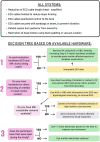Artifact Reduction in Simultaneous EEG-fMRI: A Systematic Review of Methods and Contemporary Usage
- PMID: 33776886
- PMCID: PMC7991907
- DOI: 10.3389/fneur.2021.622719
Artifact Reduction in Simultaneous EEG-fMRI: A Systematic Review of Methods and Contemporary Usage
Abstract
Simultaneous electroencephalography-functional MRI (EEG-fMRI) is a technique that combines temporal (largely from EEG) and spatial (largely from fMRI) indicators of brain dynamics. It is useful for understanding neuronal activity during many different event types, including spontaneous epileptic discharges, the activity of sleep stages, and activity evoked by external stimuli and decision-making tasks. However, EEG recorded during fMRI is subject to imaging, pulse, environment and motion artifact, causing noise many times greater than the neuronal signals of interest. Therefore, artifact removal methods are essential to ensure that artifacts are accurately removed, and EEG of interest is retained. This paper presents a systematic review of methods for artifact reduction in simultaneous EEG-fMRI from literature published since 1998, and an additional systematic review of EEG-fMRI studies published since 2016. The aim of the first review is to distill the literature into clear guidelines for use of simultaneous EEG-fMRI artifact reduction methods, and the aim of the second review is to determine the prevalence of artifact reduction method use in contemporary studies. We find that there are many published artifact reduction techniques available, including hardware, model based, and data-driven methods, but there are few studies published that adequately compare these methods. In contrast, recent EEG-fMRI studies show overwhelming use of just one or two artifact reduction methods based on literature published 15-20 years ago, with newer methods rarely gaining use outside the group that developed them. Surprisingly, almost 15% of EEG-fMRI studies published since 2016 fail to adequately describe the methods of artifact reduction utilized. We recommend minimum standards for reporting artifact reduction techniques in simultaneous EEG-fMRI studies and suggest that more needs to be done to make new artifact reduction techniques more accessible for the researchers and clinicians using simultaneous EEG-fMRI.
Keywords: BOLD; artifact; ballistocardiogram; electroencephalography; motion; simultaneous EEG-fMRI.
Copyright © 2021 Bullock, Jackson and Abbott.
Conflict of interest statement
The Florey Institute of Neuroscience and Mental Health acknowledges a partnership with Brain Products GmbH toward development of commercially available carbon wire loops (CWL) for direct artifact detection and correction. This includes work that was in part supported by an Australian Government Global Connections Fund Bridging Grant (Application number 279313678, awarded to DA). The authors declare that the research was conducted in the absence of any other commercial or financial relationships that could be construed as a potential conflict of interest.
Figures







Similar articles
-
NeuXus open-source tool for real-time artifact reduction in simultaneous EEG-fMRI.Neuroimage. 2023 Oct 15;280:120353. doi: 10.1016/j.neuroimage.2023.120353. Epub 2023 Aug 29. Neuroimage. 2023. PMID: 37652114
-
Real-time EEG artifact correction during fMRI using ICA.J Neurosci Methods. 2016 Dec 1;274:27-37. doi: 10.1016/j.jneumeth.2016.09.012. Epub 2016 Sep 30. J Neurosci Methods. 2016. PMID: 27697458
-
Towards high-quality simultaneous EEG-fMRI at 7 T: Detection and reduction of EEG artifacts due to head motion.Neuroimage. 2015 Oct 15;120:143-53. doi: 10.1016/j.neuroimage.2015.07.020. Epub 2015 Jul 11. Neuroimage. 2015. PMID: 26169325
-
Simultaneous electroencephalography-functional magnetic resonance imaging for assessment of human brain function.Front Syst Neurosci. 2022 Jul 28;16:934266. doi: 10.3389/fnsys.2022.934266. eCollection 2022. Front Syst Neurosci. 2022. PMID: 35966000 Free PMC article. Review.
-
EEG-Informed fMRI: A Review of Data Analysis Methods.Front Hum Neurosci. 2018 Feb 6;12:29. doi: 10.3389/fnhum.2018.00029. eCollection 2018. Front Hum Neurosci. 2018. PMID: 29467634 Free PMC article. Review.
Cited by
-
Revolutionizing Sleep Science: A Narrative Review of the Historical Origins and Current Applications of Sleep Neuroimaging.Nat Sci Sleep. 2025 May 26;17:1079-1099. doi: 10.2147/NSS.S492585. eCollection 2025. Nat Sci Sleep. 2025. PMID: 40453632 Free PMC article. Review.
-
Safety of Simultaneous Scalp and Intracranial EEG and fMRI: Evaluation of RF-Induced Heating.Bioengineering (Basel). 2025 May 24;12(6):564. doi: 10.3390/bioengineering12060564. Bioengineering (Basel). 2025. PMID: 40564381 Free PMC article.
-
Heartbeat-evoked neural response abnormalities in generalized anxiety disorder during peripheral adrenergic stimulation.Neuropsychopharmacology. 2024 Jul;49(8):1246-1254. doi: 10.1038/s41386-024-01806-5. Epub 2024 Jan 30. Neuropsychopharmacology. 2024. PMID: 38291167 Free PMC article. Clinical Trial.
-
EEG-LLAMAS: A low-latency neurofeedback platform for artifact reduction in EEG-fMRI.Neuroimage. 2023 Jun;273:120092. doi: 10.1016/j.neuroimage.2023.120092. Epub 2023 Apr 5. Neuroimage. 2023. PMID: 37028736 Free PMC article.
-
Simultaneous EEG-fMRI: What Have We Learned and What Does the Future Hold?Sensors (Basel). 2022 Mar 15;22(6):2262. doi: 10.3390/s22062262. Sensors (Basel). 2022. PMID: 35336434 Free PMC article. Review.
References
-
- Manganas S, Bourbakis N. A Comparative survey on simultaneous EEG-fMRI methodologies. In: 2017 IEEE 17th International Conference on Bioinformatics and Bioengineering (BIBE). New York, NY: IEEE; (2017). p. 1–8. 10.1109/BIBE.2017.00-87 - DOI
Publication types
LinkOut - more resources
Full Text Sources
Other Literature Sources

